Why Finding the Right Cardamom Substitute in Curry Matters
Cardamom substitute in curry is one of the most searched spice swaps for good reason - this "queen of spices" brings a complex blend of sweet, floral, and citrusy notes that can make or break your curry's flavor profile. When you're halfway through cooking and realize you're out of cardamom, don't panic.
Quick Cardamom Substitutes for Curry:
- Cinnamon + Ginger - Use 1/2 tsp each to replace 1 tsp cardamom (best for chicken/vegetable curries)
- Cinnamon + Cloves - Use 1/2 tsp each to replace 1 tsp cardamom (best for meat/seafood curries)
- Ground Coriander - Use 2 tsp to replace 1 tsp cardamom (best for dal/lentil curries)
- Allspice - Use 1/2 tsp to replace 1 tsp cardamom (good all-purpose substitute)
Cardamom's unique flavor comes from its complex chemical compounds that create notes ranging from minty and eucalyptus-like to warm and spicy. This complexity is what makes finding a perfect substitute challenging - but not impossible.
Whether you're dealing with green cardamom's bright, aromatic character or black cardamom's smoky intensity, the right substitute combination can save your curry and keep those bold flavors intact.
I'm Joseph Rosenblatt, founder of a premium spice company with years of experience helping home cooks steer cardamom substitute in curry challenges through recipe development and global spice sourcing. I've tested countless spice combinations to help busy cooks create authentic flavors without hunting down hard-to-find ingredients.
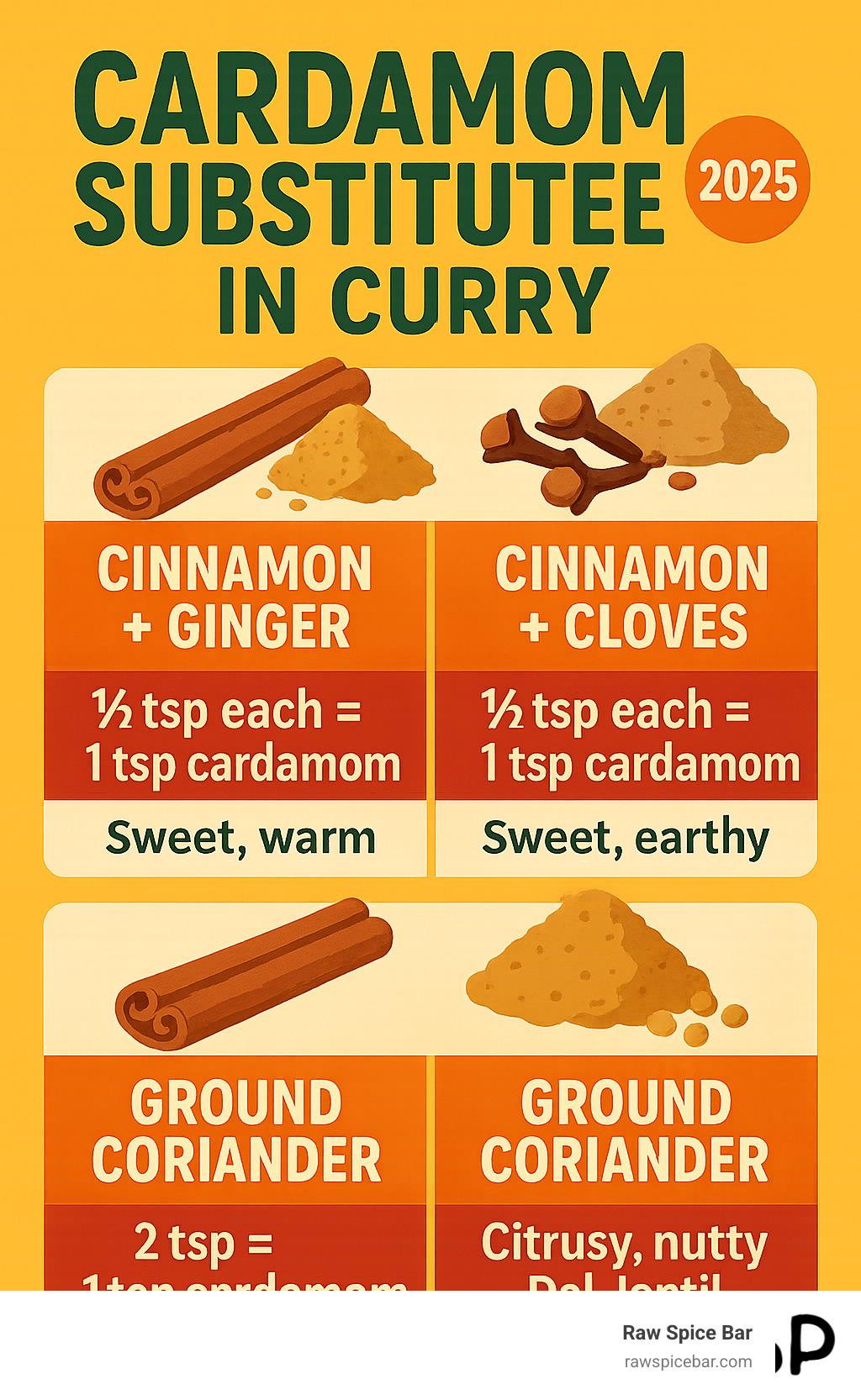
Glossary for cardamom substitute in curry:
- alternative to cardamom pods
- best cardamom substitute
- cardamom substitute for baking
Understanding Cardamom's Unique Role in Curry
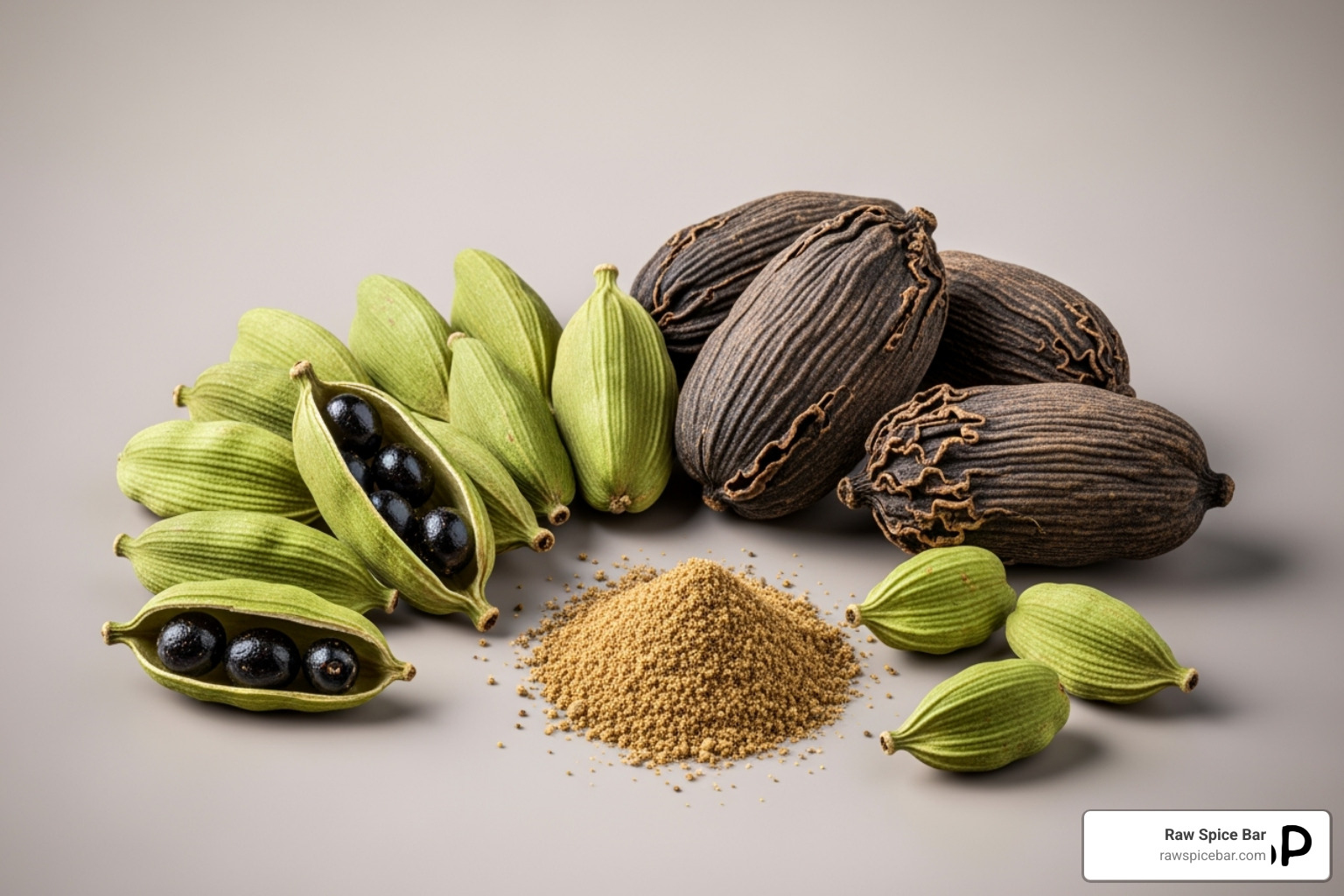
There's a reason cardamom earned the title "Queen of Spices" - and it's not just royal marketing. This little pod packs one of the most complex flavor profiles you'll find in any spice cabinet. When you're searching for a cardamom substitute in curry, you're not just looking for any warm spice to toss in. You're trying to capture a flavor that's simultaneously citrusy, minty, floral, woody, and slightly medicinal all at once.
Think of cardamom as the sophisticated friend who speaks five languages fluently. In curry, it brings fruity sweetness that balances rich meats, herbal brightness that lifts heavy sauces, and warming spice that ties everything together. It's this multitasking ability that makes cardamom so essential in traditional Indian and Middle Eastern cooking.
Without cardamom, your curry might taste good, but it'll be missing that signature aromatic lift that makes you close your eyes and sigh with satisfaction. It's the difference between a nice meal and an unforgettable one.
To truly appreciate how cardamom fits into the bigger picture, it helps to understand the Essential Spices in Indian Cooking and explore exactly What is Curry?.
The Two Faces of Cardamom: Green vs. Black
Here's where things get interesting - not all cardamom is created equal. When you're hunting for a cardamom substitute in curry, you need to know which type your recipe is calling for, because green cardamom and black cardamom are like distant cousins who took very different life paths.
| Feature | Green Cardamom | Black Cardamom |
|---|---|---|
| Flavor Profile | Sweet, aromatic, citrusy with mint and eucalyptus notes | Smoky, intense, earthy with bold minty undertones |
| Common Use in Curries | Light curries, chicken dishes, vegetable curries, desserts | Heavy meat curries, biryanis, robust stews |
| Best Substitute Approach | Focus on sweet and aromatic notes (cinnamon + ginger) | Focus on smoky and intense notes (cloves + cumin) |
Green cardamom is the delicate one - think of it as sun-dried elegance. These smaller pods deliver aromatic sweetness with those lovely citrusy and minty notes that make your kitchen smell like heaven. Most curry recipes call for green cardamom, especially in lighter dishes where its gentle complexity can shine.
Black cardamom, on the other hand, is the bold sibling who spent time around campfires. These larger pods are smoke-dried over open flames, giving them an intense, almost bacon-like smokiness. When a recipe calls for black cardamom in curry, it's usually for hearty meat dishes that can handle its robust, earthy personality.
The difference matters because your substitute strategy changes completely. Green cardamom calls for delicate, aromatic replacements, while black cardamom needs something with serious smoky intensity. For more detailed information about cardamom's health benefits and properties, you can Learn about cardamom's properties.
Why a Perfect Substitute is Elusive
Let's be honest - finding a perfect cardamom substitute in curry is like trying to replace a symphony orchestra with a solo piano. It might sound beautiful, but it's definitely not the same experience.
Cardamom's complexity comes from unique chemical compounds that create this incredible flavor layering. You get citrus brightness, mint coolness, spice warmth, and herbal freshness all happening at once. No single spice in your pantry can pull off this multi-dimensional magic trick.
But here's the good news - while we can't perfectly replicate cardamom, we can absolutely create delicious curries that satisfy your taste buds and complement your other spices beautifully. The secret is understanding that we're not trying to fool anyone into thinking they're eating cardamom. We're aiming to layer flavors in a way that creates a similarly complex and satisfying taste experience.
Think of it as cooking jazz - you're improvising within a structure, and sometimes those improvisations turn out even better than the original plan.
The Best Single Spice Swaps for Cardamom
Sometimes the simplest solution is the best one. When you need a cardamom substitute in curry and don't want to fuss with complex spice blends, reaching for a single pantry staple can save the day. While none of these individual spices will perfectly replicate cardamom's intricate flavor symphony, each one captures important notes that can keep your curry delicious and aromatic.
The secret to success with single-spice substitutions is starting small. Most of these alternatives pack more punch than cardamom, so a little restraint goes a long way.
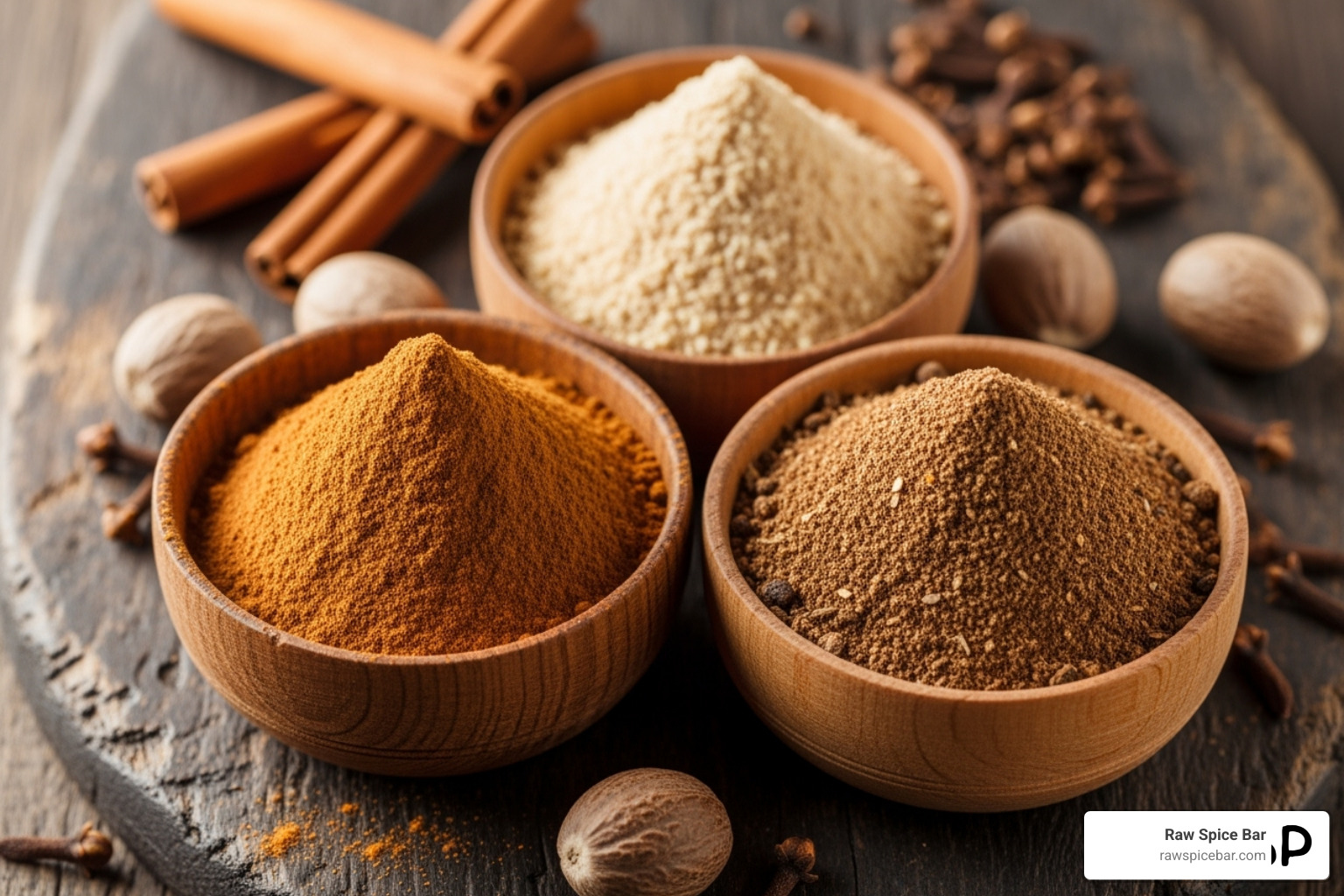
Cinnamon
Cinnamon is probably sitting in your spice rack right now, making it the most accessible cardamom alternative. This beloved spice brings warmth, sweetness, and a lovely woodiness that echoes some of cardamom's most comforting qualities.
Cinnamon really shines in creamy curries and tomato-based dishes where its natural sweetness can meld beautifully with rich sauces. Think butter chicken or coconut-based vegetable curries - cinnamon feels right at home in these recipes.
Start with half the amount your recipe calls for in cardamom, then taste and adjust. If you need 1 teaspoon of cardamom, begin with just 1/2 teaspoon of cinnamon. You can always add more, but you can't take it back once it's in the pot.
Nutmeg
Don't overlook nutmeg as a cardamom substitute - this earthy, sweet spice has a surprising floral quality that works beautifully in savory dishes. While it won't give you cardamom's bright citrus notes, nutmeg brings a rich, warming depth that's particularly lovely in heartier curries.
Meat-based curries are where nutmeg truly excels. Lamb curry, beef masala, or any robust dish with bold flavors can handle nutmeg's pungent character. It adds complexity without competing with the other spices.
Like cinnamon, use half the amount to start. Nutmeg can quickly overwhelm a dish, so treat it with respect and add gradually.
Allspice
Here's where things get interesting. Allspice is nature's spice blend - a single berry that tastes like a combination of cloves, cinnamon, and nutmeg all rolled into one. This makes it an incredibly smart choice when you need complexity from just one ingredient.
Allspice is your go-to versatile substitute that works well in most curry styles. Whether you're making chicken curry, vegetable curry, or seafood dishes, allspice brings enough complexity to fill the gap left by missing cardamom.
Start with half the amount and taste as you go. The combined flavors in allspice can be quite strong, so a gentle hand is key.
Ginger
This one might surprise you, but ginger is actually cardamom's botanical cousin - they're both part of the same plant family. This family connection shows in their shared zesty, pungent brightness that adds life to savory dishes.
Fresh or ground ginger brings that spicy kick and aromatic freshness that cardamom is known for. It's especially effective in lighter curries where you want brightness rather than heavy warmth.
Ground ginger can often be used 1:1 as a cardamom substitute in curry. If you're using fresh ginger, use about half the amount since it's more potent. For more creative ways to use ginger and other substitutions, our Best Cardamom Substitute guide has you covered.
Coriander
Ground coriander brings lemony, earthy notes with a subtle floral quality that can complement many of the flavors cardamom typically provides. While it lacks cardamom's sweetness and mint-like freshness, its aromatic qualities make it surprisingly effective in the right dishes.
Coriander works best in lentil curries (dal) and vegetable-based dishes where its earthy character can shine without competing with heavy meats or rich sauces.
Use double the amount of ground coriander compared to what your recipe calls for in cardamom. So if you need 1 teaspoon of cardamom, try 2 teaspoons of ground coriander. This might seem like a lot, but coriander is gentler than cardamom and needs that extra quantity to make its presence felt.
If you're curious about more ways to work with coriander, check out our Best Coriander Substitute guide for additional inspiration.
Crafting the Perfect Cardamom Substitute in Curry with Spice Blends
While single spices can work in a pinch, the real secret to mastering cardamom substitute in curry lies in combining spices. Think about it - cardamom itself is incredibly complex, so why not fight complexity with complexity? When you blend two or more spices together, you're creating layers of flavor that can come surprisingly close to cardamom's unique character.
The beauty of spice blending is that you can tailor your substitute to match your specific curry. A rich lamb curry needs different flavor notes than a delicate vegetable dal. By understanding which combinations work best with different types of curries, you'll never feel lost when that little cardamom jar comes up empty.
If you're curious about creating your own custom blends beyond just substitutes, check out our guide on How to Blend Your Own Spice Mixes at Home.
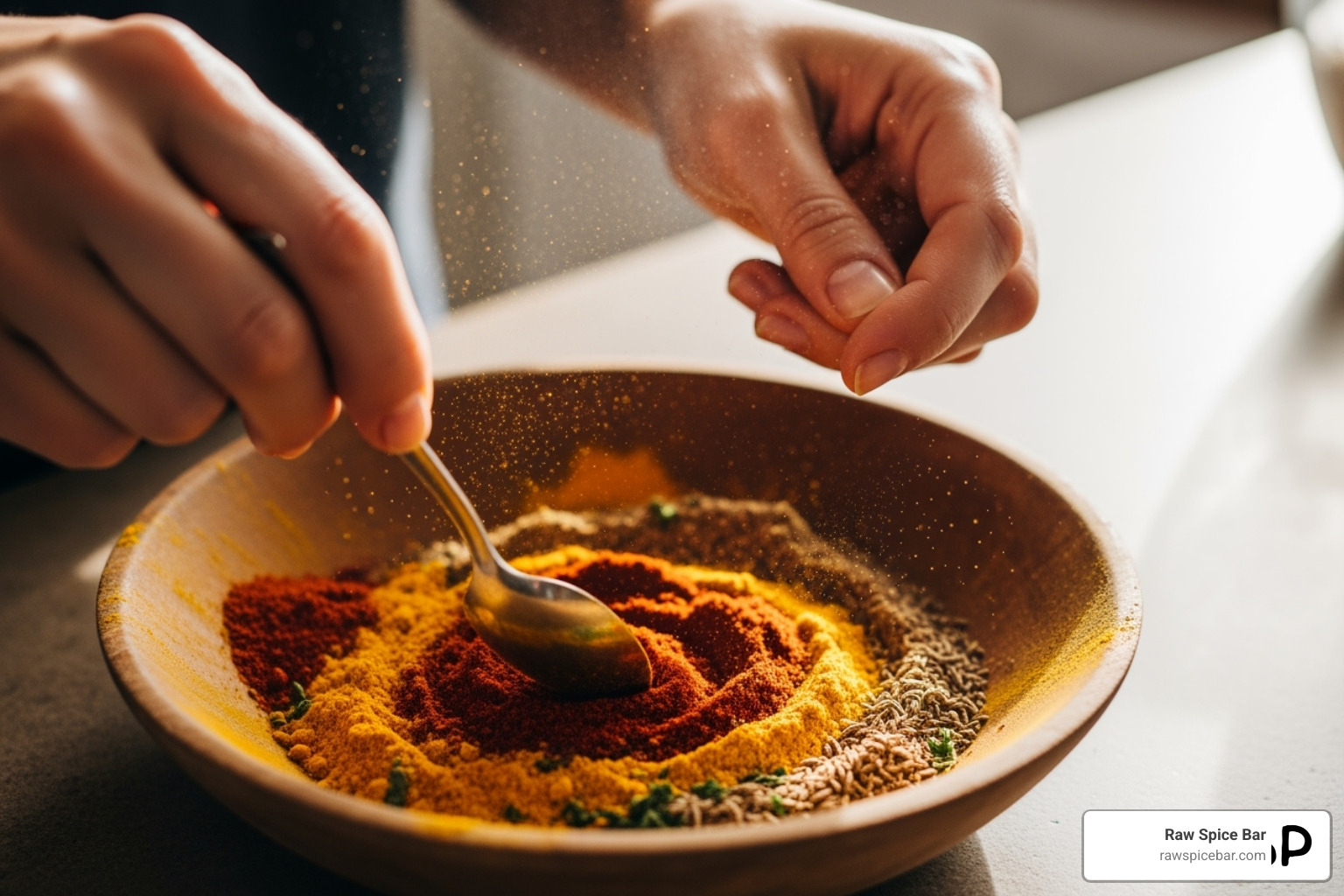
Cinnamon and Cloves: The Classic Combination
This is the power couple of cardamom substitute in curry blends, especially when you're making meat or seafood curries. Cloves bring intensity - that bold, almost numbing warmth that can stand up to rich proteins. Cinnamon adds sweetness and woody depth. Together, they create something magical that captures both cardamom's warmth and its complexity.
The trick with this combination is balance. Cloves can easily overpower a dish, so we use equal parts but start conservatively. Use 1/2 teaspoon each of ground cloves and ground cinnamon to replace 1 teaspoon of cardamom. This gives you that signature warmth and intensity that makes meat curries so satisfying.
Cinnamon and Ginger: The Aromatic Duo
Here's where things get interesting - ginger is actually cardamom's botanical cousin, both belonging to the same plant family. This pairing works beautifully in chicken or vegetable curries because it brings both warmth and brightness. Cinnamon provides the sweet, woody base while ginger adds that zesty kick that mimics cardamom's fresh, pungent notes.
This combination is forgiving and versatile. Mix 1/2 teaspoon of ground cinnamon with 1/2 teaspoon of ground ginger for every teaspoon of cardamom your recipe calls for. The equal ratio keeps things balanced, and you'll be amazed how this simple blend can transform your curry.
Cumin and Coriander: The Earthy Base
Now, this combination takes a different approach to cardamom substitute in curry. Instead of trying to mimic cardamom's sweet-floral notes, cumin and coriander create a savory foundation that works especially well in lentil and vegetable curries. Think of it as building flavor from the ground up.
Cumin brings earthiness and warmth, while coriander adds lemony brightness and subtle floral notes. When you combine them, you get a robust base that can anchor your curry's flavor profile. Use 1/2 teaspoon of ground cumin plus 1 teaspoon of ground coriander to create this earthy foundation. The extra coriander helps bridge the gap toward cardamom's more delicate notes.
This blend won't fool anyone into thinking they're tasting cardamom, but it will create a deeply satisfying curry that doesn't feel like it's missing anything important.
Adjusting for Form: Whole Pods vs. Ground Spice
The form of cardamom you're replacing makes a huge difference in how you approach finding the perfect cardamom substitute in curry. Think of it this way: whole pods are like slow-release flavor capsules, while ground cardamom is an instant flavor bomb.
When you crack open whole cardamom pods and let them simmer in your curry, they release their aromatic oils gradually, creating layers of flavor that build throughout the cooking process. Ground cardamom, on the other hand, hits you immediately with intense flavor but can lose its punch if cooked too long.
This is why understanding Why Freshly Ground Spices Make a Difference can truly transform your cooking. Fresh spices always pack more flavor than their pre-ground counterparts that have been sitting on shelves.
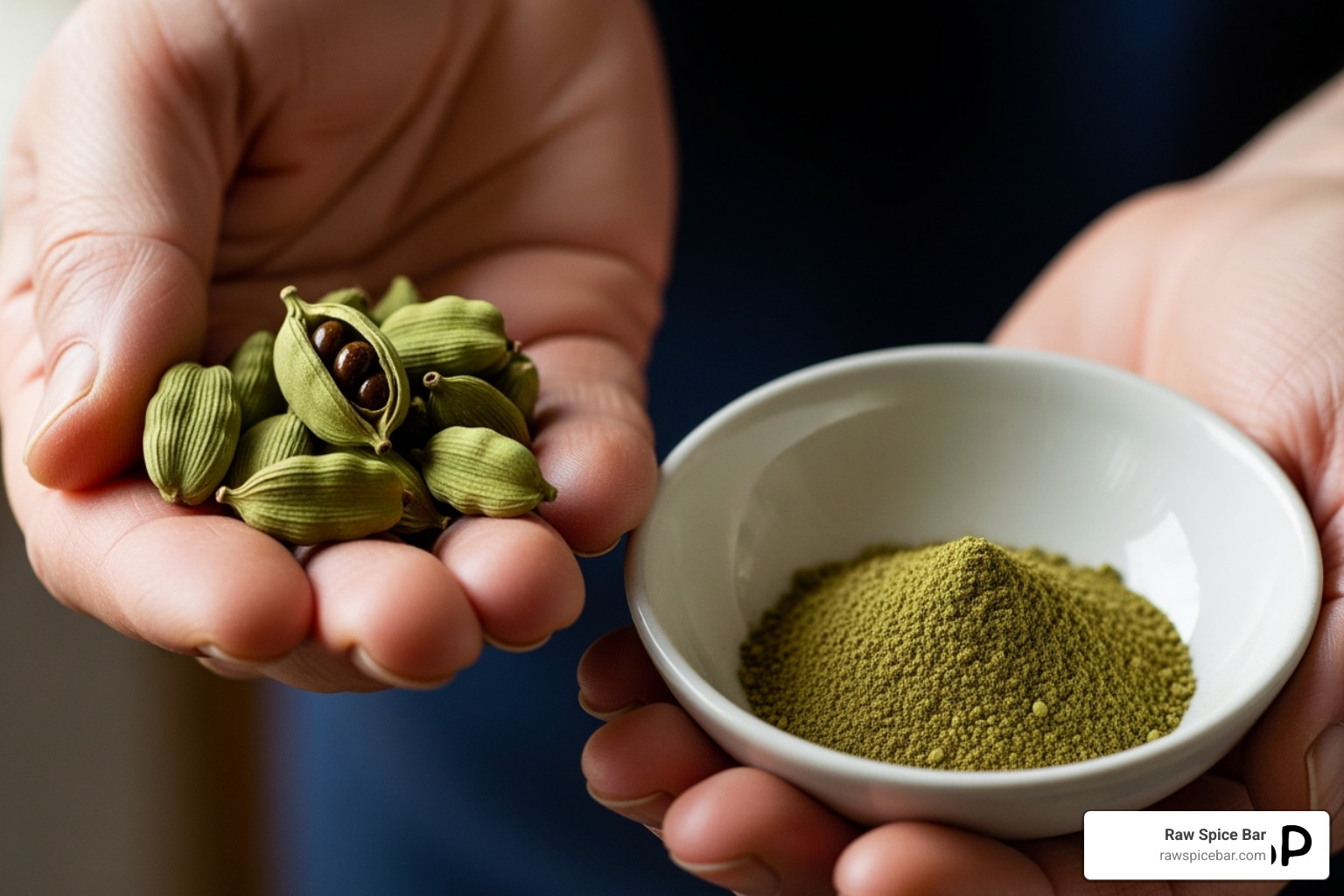
Finding a Green Cardamom Substitute in Curry
Green cardamom brings those bright, sweet, and almost floral notes that make curries sing. When you're looking for a substitute, focus on capturing that aromatic sweetness rather than just heat or warmth.
For whole green cardamom pods, you want substitutes that can infuse slowly into your curry base. Try adding a small cinnamon stick or a few whole cloves to your tempering oil at the start of cooking. These will release their flavors gently, similar to how cardamom pods work their magic. If you have star anise on hand, a tiny piece can add some of that distinctive aromatic quality.
For ground green cardamom, your best bet is that winning combination of cinnamon and ginger we talked about earlier - half a teaspoon of each to replace one teaspoon of cardamom. Allspice also works beautifully here because it naturally combines several warm spice flavors. Nutmeg can add that sweet, aromatic note, but use it sparingly since it can quickly overpower your dish.
Finding a Black Cardamom Substitute in Curry
Black cardamom is a completely different beast - it's all about that smoky, earthy intensity that comes from being dried over open fires. When you're missing this powerhouse spice, think bold and smoky.
For whole black cardamom pods, reach for whole cloves to get some of that pungent punch. Here's a clever trick: add a tiny pinch of smoked paprika to your cooking oil early in the process. It sounds unusual, but it mimics that distinctive smoky character beautifully. Some cooks swear by using a small piece of star anise, which can provide a similar numbing sensation on the tongue.
For ground black cardamom, combine ground cloves with cumin - start with about a quarter teaspoon of each and adjust from there. Adding just a whisper of smoked paprika to this blend brings back that essential smoky element that makes black cardamom so special in hearty meat curries.
How to Convert and Adjust Quantities
Here's the golden rule that'll save you every time: roughly six whole cardamom pods equal one teaspoon of ground cardamom. Keep this conversion in your back pocket - it's incredibly handy when recipes call for different forms than what you have.
When working with whole spice substitutes, add them early in your cooking process, just like you would with cardamom pods. Let them infuse into your oil during tempering, building those flavor layers from the ground up. Remember to fish out whole spices before serving - nobody wants to bite into a whole clove!
For ground substitutes, mix them right into your spice blend or add them when you'd normally add the cardamom. They'll integrate immediately and distribute evenly throughout your curry.
The most important advice? Start small and taste as you go. It's much easier to add more flavor than to rescue an over-spiced curry. Begin with half the amount you think you need, then build up gradually until your curry tastes just right.
Want to take your spice game to the next level? Consider Toasting Spices before grinding them. This simple step releases essential oils and creates deeper, more complex flavors in your substitute blends.
Frequently Asked Questions about Cardamom Substitutes
When you're navigating cardamom substitute in curry, a few common questions always come up. Let me address the ones I hear most often from home cooks who are trying to perfect their curry game.
Can I just leave cardamom out of my curry recipe?
This is probably the most common question I get, and my answer is: it depends on how much your recipe calls for. If we're talking about a tiny amount - less than 1/2 teaspoon - you might get away with skipping it entirely. In a complex curry loaded with other bold spices, that small amount might not make or break your dish.
But here's the thing: if your recipe calls for a full teaspoon or more of cardamom, you're looking at a key flavor player, not just a supporting actor. Cardamom brings that distinctive aromatic warmth and brightness that makes curry taste authentic and complete. Without it, your dish might taste like something's missing - kind of like making chocolate chip cookies without the vanilla.
My honest recommendation? Don't risk it. When cardamom is a prominent ingredient, always reach for a suitable cardamom substitute in curry rather than crossing your fingers and hoping no one notices. Your taste buds will thank you.
Can I use Garam Masala as a cardamom substitute in curry?
Absolutely, but let's talk strategy here. Garam Masala is like the Swiss Army knife of spice blends - it contains cardamom along with other warming spices like cinnamon, cloves, and cumin. This makes it a convenient option when you're looking for a cardamom substitute in curry.
The catch? Garam Masala isn't just cardamom - it's a whole flavor party in one blend. You'll get some of those cardamom notes you're after, but you'll also be adding other distinct flavors to your curry. This isn't necessarily bad, but it will change your dish's overall profile.
Here's my approach: start with less than the recipe calls for in cardamom - maybe half or even a quarter of the amount - and taste as you go. Garam Masala is traditionally added near the end of cooking to preserve its aromatic qualities, unlike many other spices that get tempered at the beginning.
For a deeper dive into spice blends, check out the differences between Garam Masala vs. Curry Powder or explore What is Garam Masala? to understand this complex blend better.
What is the difference between allspice and cardamom?
While both spices bring warmth and fragrance to your cooking, they're actually quite different characters with unique backstories.
Allspice comes from the dried, unripe berries of the Pimenta dioica tree. Its clever name comes from the fact that it tastes like a combination of cloves, cinnamon, and nutmeg all rolled into one convenient spice. Think of it as nature's pre-made spice blend - warm, sweet, and straightforward.
Cardamom, on the other hand, is a pod from plants in the ginger family. As we've explored throughout this guide, cardamom is the more complex personality of the two. It brings fruity, nutty, herbal, woody, citrusy, and minty notes, sometimes even with a slight medicinal or peppery kick. It's like the difference between a simple, catchy pop song and a complex jazz composition - both have their place, but one is definitely more nuanced.
While cardamom offers brighter, more citrusy notes compared to allspice's direct "warm spice" approach, allspice can still work beautifully as a cardamom substitute in curry. Its multi-dimensional flavor makes it one of my go-to single-spice substitutes when you want broad warm spice flavor without the fuss of blending multiple spices together.
Conclusion
Finding the perfect cardamom substitute in curry might seem daunting at first, but armed with the right knowledge, you can confidently tackle any recipe - even when your spice cabinet isn't fully stocked. We've journeyed through cardamom's complex flavor world, explored the differences between green and black varieties, and finded how individual spices and clever combinations can save the day.
The most important takeaway? Don't let perfectionism paralyze you in the kitchen. While cardamom is wonderfully unique, its warm, aromatic essence can be captured through thoughtful substitution. Whether you reach for the cinnamon and ginger blend for a bright chicken curry or the cinnamon and cloves combination for a rich meat dish, you're equipped to make delicious choices.
Experimentation truly is key here. Your taste buds are your best teacher, and every curry is an opportunity to learn something new. Start with our suggested ratios, but don't be afraid to adjust based on what tastes right to you. Some days you might want more warmth from extra cinnamon, other times a bit more zing from additional ginger.
Remember to always start small and taste as you go. It's much easier to add another pinch of spice than to rescue an over-seasoned curry. This gentle approach will build your confidence and help you understand how different spices interact with your specific ingredients and cooking style.
Don't let a missing spice stop you from creating something wonderful. Some of the best culinary findies happen when we're forced to think creatively. That emergency substitution might just become your new favorite flavor combination.
At Raw Spice Bar, we're passionate about making global flavors accessible to every home cook. Our freshly packed, high-quality spices are designed to inspire confidence in your kitchen, whether you're following a traditional recipe or creating your own delicious variations. We believe that exploring the world through spices should be an exciting trip, not a source of stress.
So go ahead - accept the trip of spice substitution! Your next curry is going to be absolutely delicious, cardamom or not.
Explore our Best Cardamom Substitutes for all your cooking needs




